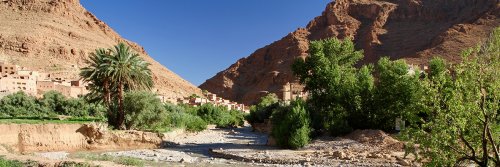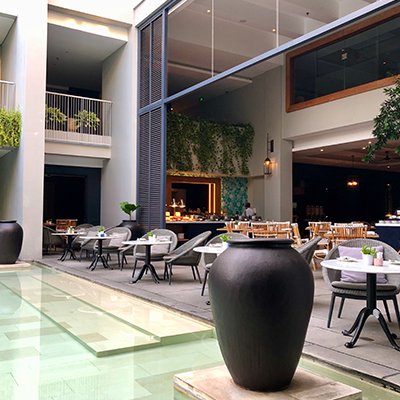Sprawled on an endless orange mat of dry land, the road from Tinghir to Todra Gorge and beyond gives panoramic views over rammed-earth houses. The road eventually comes to a remote Berber village, Aït Baha, sitting peacefully in a lush palmerie perched at the entrance to the gorge where the ancient architecture of houses in the desert are dressed with typical brightly painted Amazigh wooden doors wearing colorful geometric shapes. Life for the Berber communities who call this area home have adapted to this harsh environment where irrigated community gardens flourish with the seasons beside the Todra River. The graceful palms laden with dates in various stages of growth spread their shade over orchards of pomegranate trees and vegetable gardens connected by handmade raised walkways and small wooden bridges between clusters of mint, apricot, and almond trees.

Known for their hospitable nature, these gentle souls work as a community with strong family ties—drinking mint tea, eating sweet dates, or bread hot from the clay oven smothered in date syrup. Most mornings, you will see women taking their family cow to a nearby field to graze or flitting around the large communal garden in their long flowing robes with their faces virtually hidden beneath a headscarf known as a tahruyt, picking the day's provisions or heading down to the river laden with washing to scrub on rocks, while the kids of the village create havoc in the water. For the village women, it's a different world: constant male domination is their lot in life. Chickens live on rooftops, as do some goats and pigs. On weekends, the locals picnic at the entrance to the gorge under the palms where they spread out rugs and gossip while cooking a tajine dish over an open fire. The enticing aromas of cinnamon, cardamom, onions, and perhaps stewing lamb escape the conical lid, infusing the air as much as the lively, happy chatter.

Amidst the maze of narrow, high-walled alleys hidden behind the single main roadway leading into the canyon of Todra Gorge from Aït Baha, black-faced sheep bleat from rooftops, grandmothers bake the family bread with a loving touch. Local village girls dance in the street on the eve of weddings. In the late afternoon, women gossip on house steps, kids ride rusty bikes, and men huddle outside quirky cafes sipping mint tea. Five times a day, muezzins cry out the Islamic call to prayer from the minarets of mosques, which echo around the mountains. Their traditional lives ebb and flow harmoniously with the seasons and the water running through the gorge.

Todra Gorge, in the High Atlas Mountains of Morocco, will take your breath away. The color of the massive cliff faces that can reach up to 300 meters tall morph in hues throughout the day from earthy tones of deep red to pinkish-orange, and what is a trickle of water in the river bed during the dry summer months to a raging torrent engulfing the causeway during the wet season where the gorge narrows to a mere 10 meters in the last 600-meter stretch of the gorge. This famous canyon has been carved by wind and rain over eons in a mind-blowing display of nature’s force and creativity.

Nomadic shepherds appear on the hillsides like Pied Pipers, with flocks of sheep or goats shimmying over rocks or rough stairs built into the cliff face. Bedraggled washing flaps on rope lines strung up outside the gaping mouths of caves halfway up cliff faces in the middle of nowhere. Sad-eyed donkeys plod along rocky riverbeds carrying makeshift water containers or laden with heavy and richly embroidered rugs. These beasts of burden have the weight of the world on their bowed backs. Ad hoc stalls selling typical tourist goods sit at the base of the cliff, where many tourists pause and paddle in the shallow riverbed. Rock climbers attempt to scamper up the cliffs like minuscule insects, and trekkers take off for long walks in the wild landscape, where over 490 different hiking routes can be found.

To get to Aït Baha, the doorway to Todra Gorge, you must first go through the town of Tinghir. Its streets are heavy with fine dust constantly blowing unless you make your way to the city's palmerie, which are known as some of the most beautiful in Morocco. This is the place to buy a unique, locally handcrafted Berber rug—if you can arrange for it to somehow get shipped home. There's a museum in Sheikh Basou Ou-Ali's kasbah for the curious tourist. The narrow streets of the Aït el Haj Ali town district are cloaked in high adobe buildings that have been preserved for centuries and is the area of artisanal weavers and bazaars. Tinghir is known for its pottery, souks, and old Jewish Quarter.
Traveling through this part of Morocco can be challenging unless you organize a private tour or are prepared to immerse yourself by hopping on and off local buses.
Gail Palethorpe, a self proclaimed Australian gypsy, is a freelance writer, photographer and eternal traveller. Check out her website Gail Palethorpe Photography and her Shutterstock profile.















